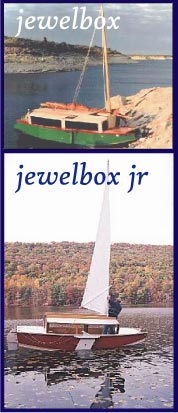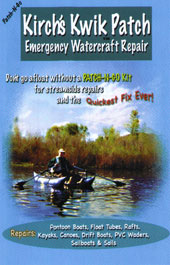
 Custom Search
|
| boat plans |
| canoe/kayak |
| electrical |
| epoxy/supplies |
| fasteners |
| gear |
| gift certificates |
| hardware |
| hatches/deckplates |
| media |
| paint/varnish |
| rope/line |
| rowing/sculling |
| sailmaking |
| sails |
| tools |
| join |
| home |
| indexes |
| classifieds |
| calendar |
| archives |
| about |
| links |
| Join Duckworks Get free newsletter CLICK HERE |
|
|
| Frame in Skin Boat Construction |
by Steve Bosquette
- Mt Laurel, New Jersey - USA |
It all began with it being time to build another boat. So far I have had the pleasure to build 14 boats. Not as prolific as some in the Duckworks Family but not too bad. I am recently retired and looking to build a bigger boat than what I am using now. I recently purchased an older Ford Aerostar. It can accommodate a boat 8 ft. long and 48 inches wide. I have carried my Dyer Dink in it this past season. I am a big guy so I need a bigger boat. The obvious options are to build a modular boat to put inside the van, or a longer boat to put on top, or lug a trailer around. I've done the trailer thing for years and with no place to keep it at home it is not my first choice. Putting the boat on top means something light enough to heft onto the roof. Again not my first choice. The modular choice seems just the ticket this time around. So off I go to the plans section in Duckworks. Ken Simpson of Arizona has lots of viable plans for modular “portable boats”. I have perused each one carefully, wanting something more than 8 feet, and found a few that meet my needs. I have been particularly smitten by the simple and inexpensive construction of his Coroplast boats. One day I was looking at his designs and took a piece of cardboard and started bending. I had a eureka moment and stumbled onto a possible new boat construction method. I call it FRAME IN SKIN. We all know of SOF or skin on frame where you build the frame first and cover it after. Dave Gentry has some wonderful designs using that method. But what I discovered is you can build the skin first and add the frame after. Let me explain! If you take a piece of paper or card stock and cut it into 4 x 8 inch pieces you get something like this:
Now bring the corners of one end together and tape the seam like this. Already you see where I am going with this. You have a pointy bow and a lazy non-descript stern.
If you brought the corners of the stern together making it 30 inches wide you have this. Looks like an 8 foot dingy. Notice what happens to the bow, it leans aft. Interesting!
So it is conceivable that installing a transom and putting in some framing you would have a viable small paddle boat. This gives new meaning to the “one sheet” boat idea.
Build two of them and you would have a 16 ft long canoe type boat that is modular. AHH now we're getting somewhere. The two sections would fit easily into the van. Note: I have not cut the original piece!
That would be OK, but a little tippy for me. So what if we did this, bring both ends together on another piece of 4x8 like this:
Kind of looks like a peapod boat. If we adjusted the height and fiddled with the beam we have a very easy outrigger float. When we attach this ama to the main hull we get an outrigger canoe or a proa like this:
Let's go a little further with this idea. Suppose we assemble 4 sheets of 4x8 to make an 8 x 16 flat panel. Pull the corners together to make the bow like before and pull the corners of the stern together say 6 feet wide we end up with a boat 16 feet long and 6 feet wide with an 18” freeboard. Notice that I flattened the stern so it is a flat bottom in the back of the boat with curved bilges. I have made some models with the stem in different configurations, It has been fun to see what this method will do.
Think of the easy assembly process this would afford. This material would be good to use 3M 5200 or another polyurethane adhesive. Ken Simpson used Scotch Tough Tape on his Coroplast boats, maybe that would work. You also could use epoxy or polyester resin. But you probably would wait until the shape is achieved as they both harden with no flex. That's all fine and dandy you say! Where are you going to find flexible panels like that? For years now I have been interested in using pre-made fiberglass panels for boatbuilding. In the Big Box Stores there have been fiberglass panels for use in bath rooms in shower applications. I have looked at them in the past but because they were basically FRP using polyester resin they were quite fragile. If you took a corner and bent it, it would break. If you made a boat out of the stuff and hit a dock or something you would hole the boat. SOOOO! I checked recently and discovered the following: Reading the tag on the available panels now-a-days I saw the familiar FRP (fiberglass reinforced plastic) and assumed it was the same old stuff. I picked up the corner and it bent easily. I went home, looked up the item and behold I found out that the FRP means Fiberglass Reinforced Polymer. Not polyester! The description said for interior use only. Instant disappointment! However, I read further and discovered that they said that because there is no UV protection in the material. I would think that is easily remedied by primer and paint or something. The other thing that gave me pause was that one side is molded and textured into crinkles or some other surface. That doesn't really bother me because that side would be the inside. I also found a thinner panel which is not as rigid called Poly Wall. It is less expensive but a little more flimsy and may be trickier to assemble. Framing could be wood, plastic, or metal, I suppose. There are lots of variation on the shapes and lengths of PVC. I would want the boat as maintenance free as possible so will use PVC. There are trim and board pieces that would work well as framing for this process. I will probably start with ordinary PVC pipe. Is this process viable? You be the judge. The panels are about $30 each. So the one sheet boat would be $50 or so. The canoe would be 2 panels with framing say $100. The large boat would be $150 or so. It all seems doable to me. I am going to pursue this idea and I will write a follow-up article with my results. It seems to me that the design ideas would be nearly limitless. Hopefully, some of you will experiment with this idea. Who knows, maybe one of us could be the Elon Musk of Duckworks!! Remember you too can build a boat, Sure you can! |
To comment on Duckworks articles, please visit one of the following:
|
 |















